英语中各种数字的读法
各种数字的英文表达读法
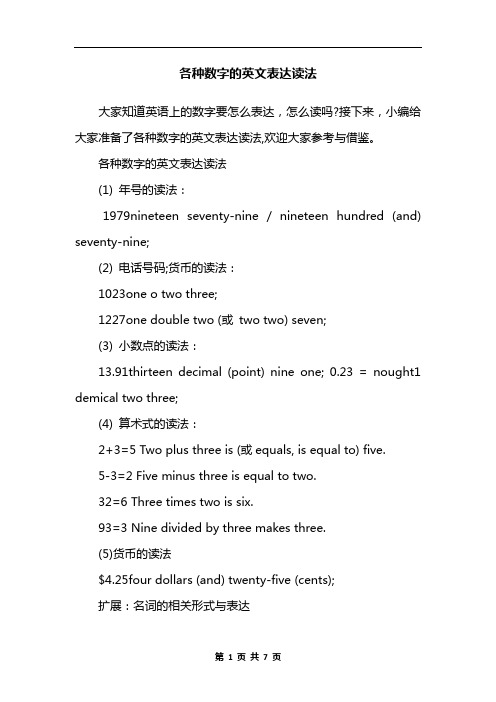
各种数字的英文表达读法大家知道英语上的数字要怎么表达,怎么读吗?接下来,小编给大家准备了各种数字的英文表达读法,欢迎大家参考与借鉴。
各种数字的英文表达读法(1) 年号的读法:1979nineteen seventy-nine / nineteen hundred (and) seventy-nine;(2) 电话号码;货币的读法:1023one o two three;1227one double two (或two two) seven;(3) 小数点的读法:13.91thirteen decimal (point) nine one; 0.23 = nought1 demical two three;(4) 算术式的读法:2+3=5 Two plus three is (或equals, is equal to) five.5-3=2 Five minus three is equal to two.32=6 Three times two is six.93=3 Nine divided by three makes three.(5)货币的读法$4.25four dollars (and) twenty-five (cents);扩展:名词的相关形式与表达在中考单项选择试题中,除了时态,名词的考查频率也较高。
一般考查以下几点:一、可数名词与不可数名词在可数名词与不可数名词上一般出现这样几类,(1)分辨是哪一类名词,并根据结论做选择。
(2)可数名词复数的不规则变化。
(3)不可数名词的量化表达。
所以,考生首先要能够明确哪些是可数名词,哪些是不可数名词。
其次,还要知道可数名词的复数的变化规则。
可数名词的变化规则一般是在单词后面加-s 或-es,如:1. desk---desks bed---beds piano---pianoshat---hats bag---bags photo---photos2. bus---buses box---boxeswatch---watches brush---brushes3. t omato---tomatoes potato---potatoeshero---heroes Negro---Negroes4. leaf---leaves knife---knives5. baby---babies family---families另外,还要记住一些特殊的名词的变化形式,如:Chinese---Chinese Japanese---JapaneseEnglishman---Englishmen Frenchman---FrenchmenRussian---Russians American---AmericansGerman1 --- Germans2child---children foot---feetman---men woman---womentooth---teeth goose --- geesedeer---deer sheep---sheep还要掌握不可数名词的量化表达有:a piece of、a bag of、a bottle of、a cup of、a glass of 。
(完整版)英语中各种数字的表达法和读法
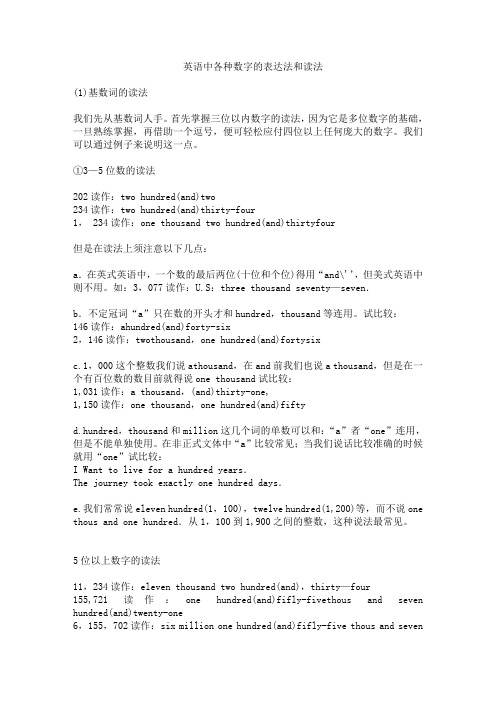
英语中各种数字的表达法和读法(1)基数词的读法我们先从基数词人手。
首先掌握三位以内数字的读法,因为它是多位数字的基础,一旦熟练掌握,再借助一个逗号,便可轻松应付四位以上任何庞大的数字。
我们可以通过例子来说明这一点。
①3—5位数的读法202读作:two hundred(and)two234读作:two hundred(and)thirty-four1, 234读作:one thousand two hundred(and)thirtyfour但是在读法上须注意以下几点:a.在英式英语中,一个数的最后两位(十位和个位)得用“and\'’,但美式英语中则不用。
如:3,077读作:U.S:three thousand seventy—seven.b.不定冠词“a”只在数的开头才和hundred,thousand等连用。
试比较:146读作:ahundred(and)forty-six2,146读作:twothousand,one hundred(and)fortysixc.1,000这个整数我们说athousand,在and前我们也说a thousand,但是在一个有百位数的数目前就得说one thousand试比较:1,031读作:a thousand,(and)thirty-one,1,150读作:one thousand,one hundred(and)fiftyd.hundred,thousand和million这几个词的单数可以和:“a”者“one”连用,但是不能单独使用。
在非正式文体中“a”比较常见;当我们说话比较准确的时候就用“one”试比较:I Want to live for a hundred years.The journey took exactly one hundred days.e.我们常常说eleven hundred(1,100),twelve hundred(1,200)等,而不说one thous and one hundred.从1,100到1,900之间的整数,这种说法最常见。
英语数字表达及读法大全
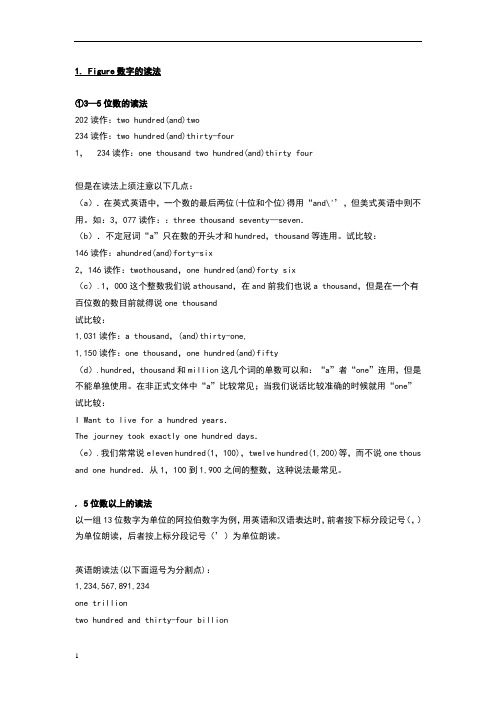
1. Figure数字的读法①3—5位数的读法202读作:two hundred(and)two234读作:two hundred(and)thirty-four1,234读作:one thousand two hundred(and)thirty four但是在读法上须注意以下几点:(a).在英式英语中,一个数的最后两位(十位和个位)得用“and\'’,但美式英语中则不用。
如:3,077读作::three thousand seventy—seven.(b).不定冠词“a”只在数的开头才和hundred,thousand等连用。
试比较:146读作:ahundred(and)forty-six2,146读作:twothousand,one hundred(and)forty six(c).1,000这个整数我们说athousand,在and前我们也说a thousand,但是在一个有百位数的数目前就得说one thousand试比较:1,031读作:a thousand,(and)thirty-one,1,150读作:one thousand,one hundred(and)fifty(d).hundred,thousand和million这几个词的单数可以和:“a”者“one”连用,但是不能单独使用。
在非正式文体中“a”比较常见;当我们说话比较准确的时候就用“one”试比较:I Want to live for a hundred years.The journey took exactly one hundred days.(e).我们常常说eleven hundred(1,100),twelve hundred(1,200)等,而不说one thous and one hundred.从1,100到1,900之间的整数,这种说法最常见。
‚5位数以上的读法以一组13位数字为单位的阿拉伯数字为例,用英语和汉语表达时,前者按下标分段记号(,)为单位朗读,后者按上标分段记号(’)为单位朗读。
英语数字表达及读法大全
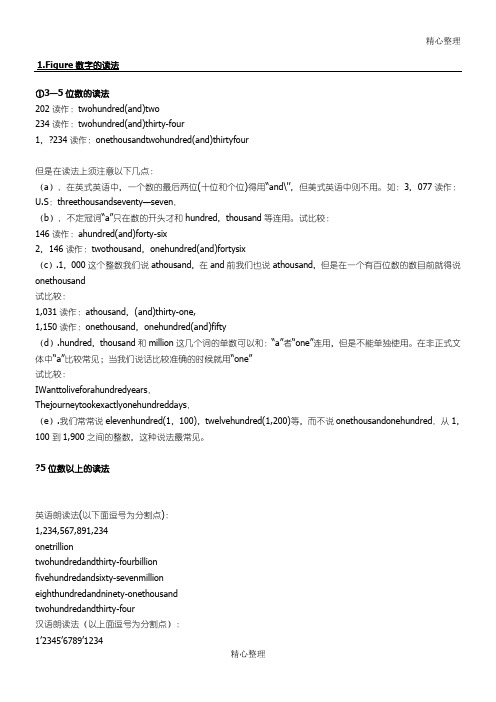
21st读作:(the)twenty-first
22nd读作:(the)twenty-second
23rd读作:(the)twenty-third
其它以此类推。
3.Fractions分数的读法
通常将分子读为基数,将分母读为序数。
1/2=a(orone)half
????????2)如果前两个数字为非“零”数字,后两位数分别为“零”,则先读出前两位数,然后将后面的两个“零”读为hundred。例如:
????????1900年读作?nineteenhundred
????????1800年读作?eighteenhundred
????????3)第三个数字为“零”(其他数字不是“零”)的年份的读法应当将该“零”读为"oh"。例如:
?5位数以上的读法
英语朗读法(以下面逗号为分割点):
1,234,567,891,234
onetrillion
twohundredandthirty-fourbillion
fivehundredandsixty-sevenmillion
eighthundredandninety-onethousand
twohundredandthirty-four
汉语朗读法(以上面逗号为分割点):
1’2345’6789’1234
一兆/万亿
二千三百四十五亿
六千七百八十九万
一千二百三十四
2.?序数词的读法
lst读作:(the)first
2nd读作:(the)second
3nd读作:(the)third
4th读作:(the)fourth
试比较:
英语中各种数字的读法
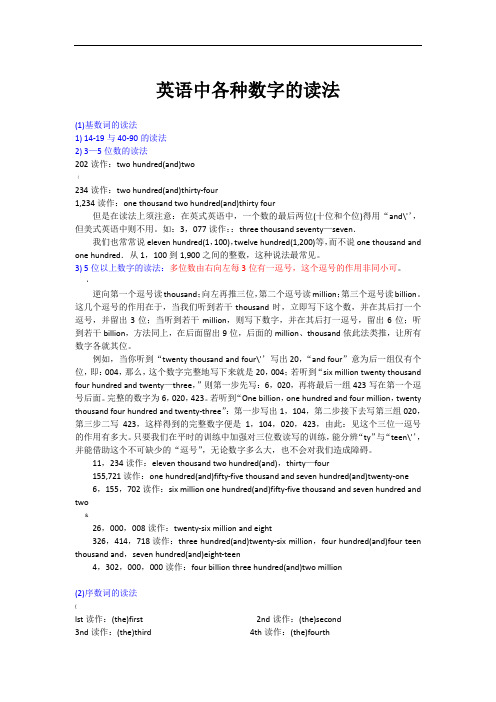
英语中各种数字的读法(1)基数词的读法1) 14-19与40-90的读法2) 3—5位数的读法202读作:two hundred(and)two(234读作:two hundred(and)thirty-four1,234读作:one thousand two hundred(and)thirty four但是在读法上须注意:在英式英语中,一个数的最后两位(十位和个位)得用“and\'’,但美式英语中则不用。
如:3,077读作::three thousand seventy—seven.我们也常常说eleven hundred(1,100),twelve hundred(1,200)等,而不说one thousand and one hundred.从1,100到1,900之间的整数,这种说法最常见。
3) 5位以上数字的读法:多位数由右向左每3位有一逗号,这个逗号的作用非同小可。
·逆向第一个逗号读thousand;向左再推三位,第二个逗号读million;第三个逗号读billion。
这几个逗号的作用在于,当我们听到若干thousand时,立即写下这个数,并在其后打一个逗号,并留出3位;当听到若干million,则写下数字,并在其后打一逗号,留出6位;听到若干billion,方法同上,在后面留出9位,后面的million、thousand依此法类推,让所有数字各就其位。
例如,当你听到“twenty thousand and four\'’写出20,“and four”意为后一组仅有个位,即:004,那么,这个数字完整地写下来就是20,004;若听到“six million twenty thousand four hundred and twenty—three,”则第一步先写:6,020,再将最后一组423写在第一个逗号后面。
完整的数字为6,020,423。
若听到“One billion,one hundred and four million,twenty thousand four hundred and twenty-three”:第一步写出1,104,第二步接下去写第三组020,第三步二写423,这样得到的完整数字便是1,104,020,423,由此:见这个三位一逗号的作用有多大。
英语听数字很重要---数词的读法大全
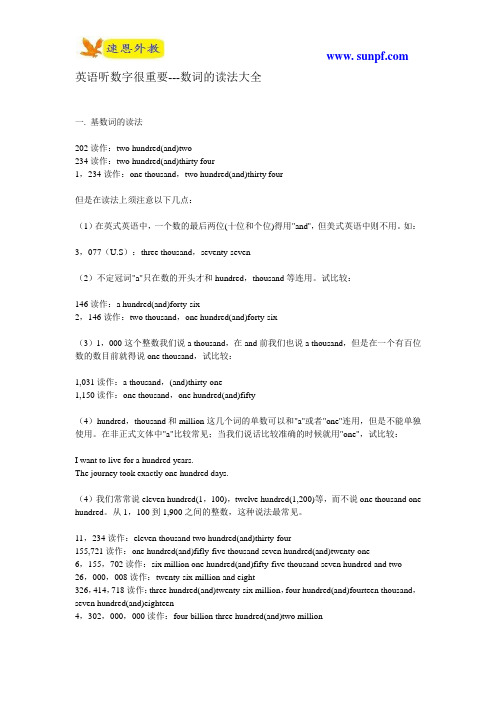
英语听数字很重要---数词的读法大全一. 基数词的读法202读作:two hundred(and)two234读作:two hundred(and)thirty four1,234读作:one thousand,two hundred(and)thirty four但是在读法上须注意以下几点:(1)在英式英语中,一个数的最后两位(十位和个位)得用"and'',但美式英语中则不用。
如:3,077(U.S):three thousand,seventy-seven(2)不定冠词"a"只在数的开头才和hundred,thousand等连用。
试比较:146读作:a hundred(and)forty-six2,146读作:two thousand,one hundred(and)forty-six(3)1,000这个整数我们说a thousand,在and前我们也说a thousand,但是在一个有百位数的数目前就得说one thousand,试比较:1,031读作:a thousand,(and)thirty-one1,150读作:one thousand,one hundred(and)fifty(4)hundred,thousand和million这几个词的单数可以和"a"或者"one"连用,但是不能单独使用。
在非正式文体中"a"比较常见;当我们说话比较准确的时候就用"one",试比较:I want to live for a hundred years.The journey took exactly one hundred days.(4)我们常常说eleven hundred(1,100),twelve hundred(1,200)等,而不说one thousand one hundred。
英语听数字很重要---数词的读法大全

英语听数字很重要---数词的读法大全一. 基数词的读法202读作:two hundred(and)two234读作:two hundred(and)thirty four1,234读作:one thousand,two hundred(and)thirty four但是在读法上须注意以下几点:(1)在英式英语中,一个数的最后两位(十位和个位)得用"and'',但美式英语中则不用。
如:3,077(U.S):three thousand,seventy-seven(2)不定冠词"a"只在数的开头才和hundred,thousand等连用。
试比较:146读作:a hundred(and)forty-six2,146读作:two thousand,one hundred(and)forty-six(3)1,000这个整数我们说a thousand,在and前我们也说a thousand,但是在一个有百位数的数目前就得说one thousand,试比较:1,031读作:a thousand,(and)thirty-one1,150读作:one thousand,one hundred(and)fifty(4)hundred,thousand和million这几个词的单数可以和"a"或者"one"连用,但是不能单独使用。
在非正式文体中"a"比较常见;当我们说话比较准确的时候就用"one",试比较:I want to live for a hundred years.The journey took exactly one hundred days.(4)我们常常说eleven hundred(1,100),twelve hundred(1,200)等,而不说one thousand one hundred。
各种数字的英文表达读法
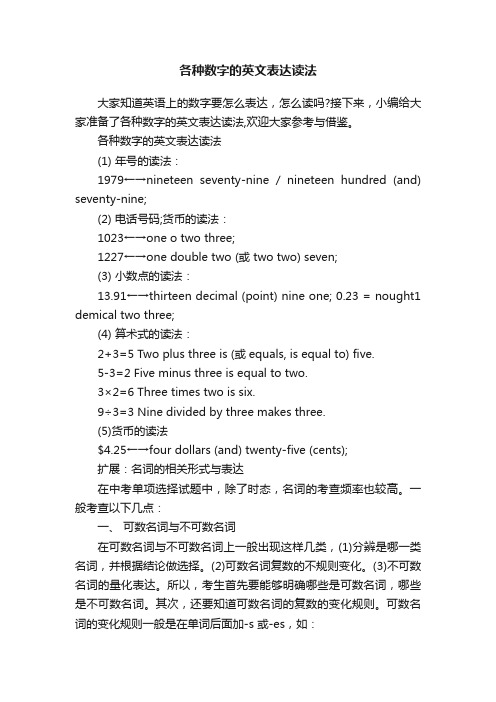
各种数字的英文表达读法大家知道英语上的数字要怎么表达,怎么读吗?接下来,小编给大家准备了各种数字的英文表达读法,欢迎大家参考与借鉴。
各种数字的英文表达读法(1) 年号的读法:1979←→nineteen seventy-nine / nineteen hundred (and) seventy-nine;(2) 电话号码;货币的读法:1023←→one o two three;1227←→one double two (或 two two) seven;(3) 小数点的读法:13.91←→thirteen decimal (point) nine one; 0.23 = nought1 demical two three;(4) 算术式的读法:2+3=5 Two plus three is (或equals, is equal to) five.5-3=2 Five minus three is equal to two.3×2=6 Three times two is six.9÷3=3 Nine divided by three makes three.(5)货币的读法$4.25←→four dollars (and) twenty-five (cents);扩展:名词的相关形式与表达在中考单项选择试题中,除了时态,名词的考查频率也较高。
一般考查以下几点:一、可数名词与不可数名词在可数名词与不可数名词上一般出现这样几类,(1)分辨是哪一类名词,并根据结论做选择。
(2)可数名词复数的不规则变化。
(3)不可数名词的量化表达。
所以,考生首先要能够明确哪些是可数名词,哪些是不可数名词。
其次,还要知道可数名词的复数的变化规则。
可数名词的变化规则一般是在单词后面加-s 或-es,如:1. desk---desks bed---beds piano---pianoshat---hats bag---bags photo---photos2. bus---buses box---boxeswatch---watches brush---brushes3. t omato---tomatoes potato---potatoeshero---heroes Negro---Negroes4. leaf---leaves knife---knives5. baby---babies family---families另外,还要记住一些特殊的名词的变化形式,如:Chinese---Chinese Japanese---JapaneseEnglishman---Englishmen Frenchman---FrenchmenRussian---Russians American---AmericansGerman1 --- Germans2child---children foot---feetman---men woman---womentooth---teeth goose --- geesedeer---deer sheep---sheep还要掌握不可数名词的量化表达有:a piece of、a bag of、a bottle of、a cup of、a glass of 。
英语数字的读法
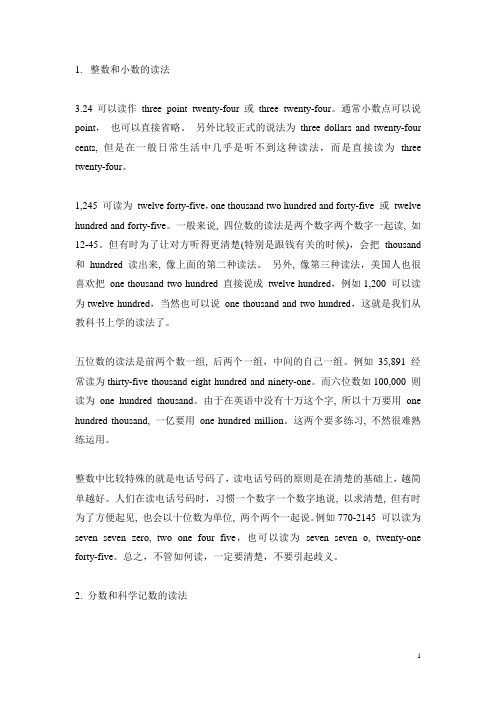
1.整数和小数的读法3.24可以读作three point twenty-four或three twenty-four。
通常小数点可以说point,也可以直接省略。
另外比较正式的说法为three dollars and twenty-four cents, 但是在一般日常生活中几乎是听不到这种读法,而是直接读为three twenty-four。
1,245 可读为twelve forty-five,one thousand two hundred and forty-five 或twelve hundred and forty-five。
一般来说, 四位数的读法是两个数字两个数字一起读, 如12-45。
但有时为了让对方听得更清楚(特别是跟钱有关的时候),会把thousand 和hundred 读出来, 像上面的第二种读法。
另外, 像第三种读法,美国人也很喜欢把one thousand two hundred 直接说成twelve hundred,例如1,200 可以读为twelve hundred,当然也可以说one thousand and two hundred,这就是我们从教科书上学的读法了。
五位数的读法是前两个数一组, 后两个一组,中间的自己一组。
例如35,891 经常读为thirty-five thousand eight hundred and ninety-one。
而六位数如100,000 则读为one hundred thousand。
由于在英语中没有十万这个字, 所以十万要用one hundred thousand, 一亿要用one hundred million。
这两个要多练习, 不然很难熟练运用。
整数中比较特殊的就是电话号码了,读电话号码的原则是在清楚的基础上,越简单越好。
人们在读电话号码时,习惯一个数字一个数字地说, 以求清楚, 但有时为了方便起见, 也会以十位数为单位, 两个两个一起说。
英语中各种数字的读法

各种数字的读法①3—5位数的读法202读作:two hundred(and)two234读作:two hundred(and)thirty-four 1,234读作:one thousand two hundred(and)thirtyfour但是在读法上须注意以下几点:在英式英语中,一个数的最后两位(十位和个位)得用“and\'’,但美式英语中则不用。
如:3,077读作:U.S:three thousand seventy—seven.我们常常说eleven hundred(1,100),twelve hundred(1,200)等,而不说one thous and one hundred.从1,100到1,900之间的整数,这种说法最常见。
5位以上数字的读法11,234读作:eleven thousand two hundred(and),thirty - four155,721读作:one hundred(and)fifty -five thousand seven hundred(and)twenty - one6,155,702读作:six million one hundred(and)fifty - five thousand seven hundred and two26,000,008读作:twenty-six million and eight326,414,718读作:three hundred(and)twenty-six million,four hundred(and)fourteen thousand,seven hundred(and)eighteen4,302,000,000读作:four billion three hundred(and)two million由以上一组数字可以看出,多位数由右向左每3位有一逗号,这个逗号的作用非同小可,在记忆数字时,它可以帮我们很大的忙!逆向第一个逗号读thousand;向左再推三位,第二个逗号读million;第三个逗号读billion;第四个逗号就是trillion。
各种数字的英文读法
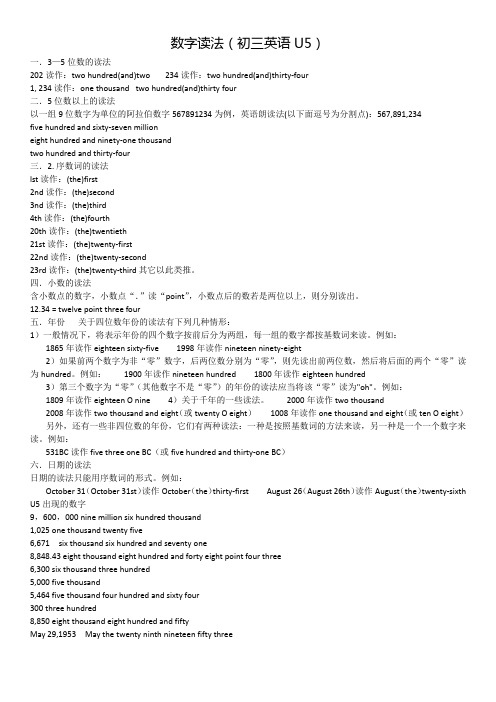
数字读法(初三英语U5)一.3—5位数的读法202读作:two hundred(and)two 234读作:two hundred(and)thirty-four1, 234读作:one thousand two hundred(and)thirty four二.5位数以上的读法以一组9位数字为单位的阿拉伯数字567891234为例,英语朗读法(以下面逗号为分割点):567,891,234five hundred and sixty-seven millioneight hundred and ninety-one thousandtwo hundred and thirty-four三.2. 序数词的读法lst读作:(the)first2nd读作:(the)second3nd读作:(the)third4th读作:(the)fourth20th读作:(the)twentieth21st读作:(the)twenty-first22nd读作:(the)twenty-second23rd读作:(the)twenty-third 其它以此类推。
四.小数的读法含小数点的数字,小数点“.”读“point”,小数点后的数若是两位以上,则分别读出。
12.34 = twelve point three four五.年份关于四位数年份的读法有下列几种情形:1)一般情况下,将表示年份的四个数字按前后分为两组,每一组的数字都按基数词来读。
例如:1865年读作 eighteen sixty-five 1998年读作 nineteen ninety-eight2)如果前两个数字为非“零”数字,后两位数分别为“零”,则先读出前两位数,然后将后面的两个“零”读为hundred。
例如: 1900年读作 nineteen hundred 1800年读作 eighteen hundred3)第三个数字为“零”(其他数字不是“零”)的年份的读法应当将该“零”读为"oh"。
英语一到十音标
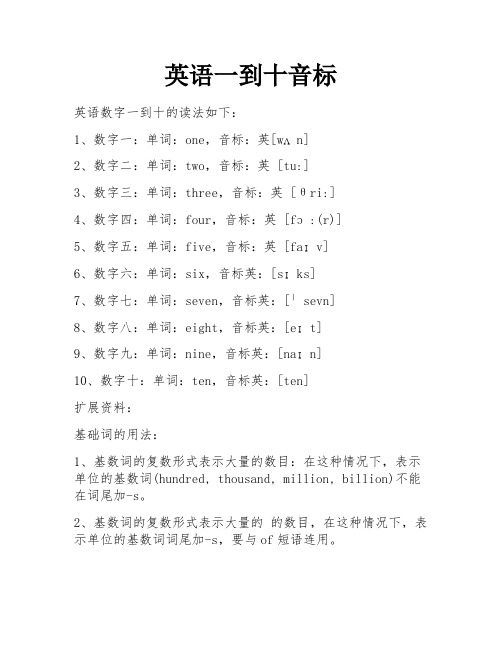
英语一到十音标
英语数字一到十的读法如下:
1、数字一:单词:one,音标:英[wʌn]
2、数字二:单词:two,音标:英 [tu:]
3、数字三:单词:three,音标:英[θri:]
4、数字四:单词:four,音标:英 [fɔ:(r)]
5、数字五:单词:five,音标:英 [faɪv]
6、数字六:单词:six,音标英:[sɪks]
7、数字七:单词:seven,音标英:[ˈsevn]
8、数字八:单词:eight,音标英:[eɪt]
9、数字九:单词:nine,音标英:[naɪn]
10、数字十:单词:ten,音标英:[ten]
扩展资料:
基础词的用法:
1、基数词的复数形式表示大量的数目:在这种情况下,表示单位的基数词(hundred, thousand, million, billion)不能在词尾加-s。
2、基数词的复数形式表示大量的的数目,在这种情况下,表示单位的基数词词尾加-s,要与of短语连用。
3.基数词在句子中的作用:基数词的作用相当于名词和形容词,在句子中可以充当主语、宾语、表语和定语。
英语中各种数字的读法

各种数字的读法①3—5位数的读法202读作:two hundred(and)two234读作:two hundred(and)thirty-four 1,234读作:one thousand two hundred(and)thirtyfour但是在读法上须注意以下几点:在英式英语中,一个数的最后两位(十位和个位)得用“and\'’,但美式英语中则不用。
如:3,077读作:U.S:three thousand seventy —seven.我们常常说eleven hundred(1,100),twelve hundred(1,200)等,而不说one thous and one hundred.从1,100到1,900之间的整数,这种说法最常见。
5位以上数字的读法11,234读作:eleven thousand two hundred(and),thirty - four155,721读作:one hundred(and)fifty - five thousand seven hundred(and)twenty - one6,155,702读作:six million one hundred(and)fifty - five thousand seven hundred and two26,000,008读作:twenty-six million and eight326,414,718读作:three hundred(and)twenty-six million,four hundred(and)fourteen thousand,seven hundred(and)eighteen4,302,000,000读作:four billion three hundred(and)two million由以上一组数字可以看出,多位数由右向左每3位有一逗号,这个逗号的作用非同小可,在记忆数字时,它可以帮我们很大的忙!逆向第一个逗号读thousand;向左再推三位,第二个逗号读million;第三个逗号读billion;第四个逗号就是trillion。
英语中各种数字读法
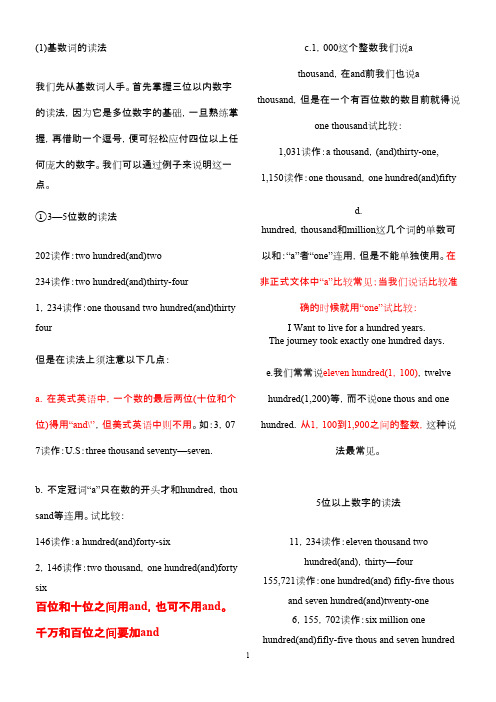
(1)基数词的读法我们先从基数词人手。
首先掌握三位以内数字的读法,因为它是多位数字的基础,一旦熟练掌握,再借助一个逗号,便可轻松应付四位以上任何庞大的数字。
我们可以通过例子来说明这一点。
①3—5位数的读法202读作:two hundred(and)two234读作:two hundred(and)thirty-four1,234读作:one thousand two hundred(and)thirty four但是在读法上须注意以下几点:a.在英式英语中,一个数的最后两位(十位和个位)得用“and\'’,但美式英语中则不用。
如:3,07 7读作:U.S:three thousand seventy—seven.b.不定冠词“a”只在数的开头才和hundred,thou sand等连用。
试比较:146读作:a hundred(and)forty-six2,146读作:two thousand,one hundred(and)forty six百位和十位之间用and,也可不用and。
千万和百位之间要加andc.1,000这个整数我们说athousand,在and前我们也说a thousand,但是在一个有百位数的数目前就得说one thousand试比较:1,031读作:a thousand,(and)thirty-one,1,150读作:one thousand,one hundred(and)fiftyd.hundred,thousand和million这几个词的单数可以和:“a”者“one”连用,但是不能单独使用。
在非正式文体中“a”比较常见;当我们说话比较准确的时候就用“one”试比较:I Want to live for a hundred years.The journey took exactly one hundred days.e.我们常常说eleven hundred(1,100),twelve hundred(1,200)等,而不说one thous and one hundred.从1,100到1,900之间的整数,这种说法最常见。
英语1-100的读法

英语1-100的读法英语1-100的读法:1、one-[wʌn]2、two-[tuː]3、three-[θriː]4、four-[fɔːr]5、five-[faɪv]6、six:[sɪks]7、seven:[ˈsev(ə)n]8、eight:[eɪt]9、nine:[naɪn]10、ten:[ten]11、eleven:[ɪˈlev(ə)n]12、twelve:[twelv]13、thirteen:[θɜːˈtiːn; ˈθɜːtiːn]14、fourteen:[fɔːˈtiːn; ˈfɔːtiːn]15、fifteen:[fɪfˈtiːn; ˈfɪftiːn]16、sixteen:[sɪksˈtiːn; ˈsɪkstiːn]17、seventeen:[sev(ə)nˈtiːn; ˈsev(ə)ntiːn]18、eighteen:[eɪˈtiːn; ˈeɪtiːn]19、nineteen:[naɪnˈtiːn; ˈnaɪntiːn]20、twenty:[ˈtwentɪ]21 、twenty-one:[ˈtwentɪˌwʌn]22 、twenty-two:[ˌtwentɪˈtuː]23、twenty-three:[tˈwentiːθrˈiː]24、twenty-four:[tˈwentiːfˈɔːr]25、twenty-five:[ˈtwentɪfaɪv]26、twenty-six:[tˈwentiːsˈɪks]27、twenty-seven:[tˈwentiːsˈevn]28、twenty-eight:[tˈwentiːˈeɪt]29、twenty-nine:[tˈwentiːnˈaɪn]30、thirty:[ˈθɜːtɪ] 31、thirty-one:[ˈθɜːtiːwˈʌn]32、thirty-two:[ˈθɜːtiːtˈuː]33、thirty-three:[ˈθɜːtɪθrɪ]34、thirty-four:[ˈθɜːtiːfˈɔːr]35 、thirty-five:[ˈθɜːtiːfˈaɪv]36、thirty-six:[ˈθɜːtiːsˈɪks]37、thirty-seven:[ˈθɜːtiːsˈevn]38 、thirty-eight:[ˈθəːtiˈeit]39、thirty-nine:[ˈθɜːtiːnˈaɪn]40、forty:[ˈfɔːtɪ]41、forty-one:[ˈfɔːtɪˌwʌn]42、forty-two:[ˈfɔːtiːtˈuː]43、forty-three:[ˈfɔːtiːθrˈiː]44、forty-four:[ˈfɔːtiːfˈɔːr]45、forty-five:[ˈfɔːtɪfaɪv]46 、forty-six:[ˈfɔːtiːsˈɪks]47、forty-seven:[ˈfɔːtiːsˈevn]48、forty-eight:[ˈfɔːtiˈeit]49、forty-nine:[ˈfɔːti ːnˈaɪn]50、fifty:[ˈfɪftɪ]51、fifty-one:[ˈfiftiwʌn]52、fifty-two:[ˈfɪftiːtˈuː]53、fifty-three:[ˈfɪftiːθrˈiː]54、fifty-four:[ˈfɪftiːfˈɔːr]55、fifty-five:[fːftifaiv]56、fifty-six:[ˈfɪftiːsˈɪks]57、fifty-seven:[ˈfɪftiːsˈevn]58、fifty-eight:[ˈfɪftiːˈeɪt]59、fifty-nine:[ˈfɪftiːnˈaɪn]60、sixty:[ˈsɪkstɪ]61、sixty-one:[ˈs ɪkstiːwˈʌn]62、sixty-two:[ˈsɪkstiːtˈuː]63、sixty-three:[ˈsɪksti ːθrˈiː]64、sixty-four:[ˈsɪkstiːfˈɔːr]65、sixty-five:[ˈsɪkstiːfˈaɪv]66、sixty-six:[ˈsɪkstiːsˈɪks]67 、sixty-seven:[ˈsɪkstiːsˈevn]68、sixty-eight:[ˈsɪkstiːˈeɪt]69、sixty-nine:[ˈsikstiˈnain]70、seventy:[ˈsev(ə)ntɪ]71、seventy-one:[ˈsevntiːwˈʌn]72、seventy-two:[ˈsevntiːtˈuː]73、seventy-three:[ˈsevntiːθrˈiː]74、seventy-four:[ˈsevəntiˈfɔː]75 、seventy-five:[ˈsevntiːfˈaɪv]76 、seventy-six:[ˈsevntiːsˈɪks]77、seventy-seven:[ˈsevntiːsˈevn]78 、seventy-eight:[ˈsevntiːˈeɪt]79、seventy-nine:[ˈsevntiːnˈaɪn]80 、eighty:[ˈeɪti]81、eighty-one:[ˈnaɪntɪ]82、eighty-two:[ˈeitiˈwʌn]83、eighty-three:[ˈeitiˈtuː]84、eighty-four:[ˈeɪtiːθrˈiː]85 、eighty-five:[ˈeitiˈfɔː]86、eighty-six:[ˈeɪtiːfˈaɪv]87 、eighty-seven:[ˈeɪtiːsˈɪks]88 、eighty-eight:[ˈeɪtiːsˈevn]89、eighty-nine:[ˈeɪtiːeɪt]90、ninety:[ˈeɪtiːnˈaɪn]91、ninety-one:[ˈnaɪntiːwˈʌn]92、ninety-two:[ˈnaɪnti ːtˈuː]93 、ninety-three:[ˈnaɪntiːθrˈiː]94 、ninety-four:[ˈnaɪntiːfˈɔːr]95、ninety-five:[ˈnaintiˈfaiv]96、ninety-six:[ˈnaɪnti ːsˈɪks]97 、ninety-seven:[ˈnaɪntiːsˈevn]98 、ninety-eight:[ˈnaɪntiːˈeɪt]99 、ninety-nine:[ˈnaɪntiːnˈaɪn]100 、one/a hundred:[wʌn] [ə; eɪ] [ˈhʌndrəd]。
- 1、下载文档前请自行甄别文档内容的完整性,平台不提供额外的编辑、内容补充、找答案等附加服务。
- 2、"仅部分预览"的文档,不可在线预览部分如存在完整性等问题,可反馈申请退款(可完整预览的文档不适用该条件!)。
- 3、如文档侵犯您的权益,请联系客服反馈,我们会尽快为您处理(人工客服工作时间:9:00-18:30)。
英语中各种数字的读法(1)年号的读法:2005←→two thousand and five1999←→nineteen ninety-nine or nineteen hundred (and) ninety-nine2008年7月15日July 15th,2008读法:2002 - Two-thousand and two 1991 - Nineteen-ninty-one 2020 - Two-thousand and twenty1900年读作nineteen hundred531BC(公元前513年)读作five three one BC(或five hundred and thirty-one BC)第三个数字为“零”(其他数字不是“零”)的年份的读法应当将该“零”读为O(字母O)。
例如:1809年读作eighteen O nine4)关于千年的一些读法。
2000年读作two thousand2008年读作two thousand and eight(或twenty O eight)1008年读作one thousand and eight(或ten O eight)(2)电话号码、货币的读法:1023←→one o two three1227←→one double two (or two two) even4.25(dollar)←→four dollars (and) twenty-five (cents)(3)小数点的读法:13.91←→thirteen de cimal (point) nineone0.23←→nought de cimal two three(4)算术式的读法:2+3=5 Two plus three is (equals, isequal to) five. Plus 是介词5-3=2 Five minus three is equal to two. Minus 是介词3×2=6 Three times two is six. or Three by two are six. Times是介词9÷3=3 Nine divided bythreemakesthree.1. “加”用plus,and或add表示;“等于”用is,make,equal等词表示。
2+3=? How much is two plus three?2+3=5Two plus three is five.Two and three is equal to five.Two and three make five.Two added to three equals five.If we add two to/and three, we get five.2. “减”用minus或take from表示10-6=?How much is ten minus six?10-6=4Ten minus six is four.Take six from ten and the remainder is four.Six (taken) from ten is four.3. “乘”用time 或multiply表示3x4=? How much is three times four?3x4=12Three times four is/are twelve.Multiply three by four,we get twelve.Three multiplied by four makes twelve.4. “除”用divided by的过去分词形式表示16÷4=? How much is sixteen divided by four?16÷4=4Sixteen divided by four is four.Sixteen divided by four equals/gives/makes four1. 分子用基数词,分母用序数词。
(1) 分子为“1”,分母用单数。
1/2 a half1/3 one third 或a third1/4 one quarter 或a quarter(2) 分子大于“1”,分母用复数。
3/4 three fourths 或three quarters24/25 twenty-four twenty-fifths2. 带分数用and 连接3 1/4 three and one fourth 或three and one quarter1 1/2 one and a half1 1/4 one and a quarter3. 百分数表示法: 百分数用基数+percent表示50%fifty percent 百分之五十3%three percent百分之三0.12%zero point one two percent 百分之零点一二4. 当分数后面接名词时,如果分数的值小于1,名词用单数;大于1时名词用复数。
4/5 meter 五分之四米5/6 inch 六分之五英寸1 1/2 hours 一个半小时(读作one and a half hours)2 3/4 meters 二又四分之三米(读作two and three-fourths meters)1. 分子用基数词,分母用序数词。
(1) 分子为“1”,分母用单数。
1/2 a half1/3 one third 或a third1/4 one quarter 或a quarter(2) 分子大于“1”,分母用复数。
3/4 three fourths 或three quarters24/25 twenty-four twenty-fifths2. 带分数用and 连接3 1/4 three and one fourth 或three and one quarter1 1/2 one and a half1 1/4 one and a quarter3. 百分数表示法: 百分数用基数+percent表示50%fifty percent 百分之五十3%three percent百分之三0.12%zero point one two percent 百分之零点一二4. 当分数后面接名词时,如果分数的值小于1,名词用单数;大于1时名词用复数。
4/5 meter 五分之四米5/6 inch 六分之五英寸1 1/2 hours 一个半小时(读作one and a half hours)2 3/4 meters 二又四分之三米(读作two and three-fourths meters)1. 分子用基数词,分母用序数词。
(1) 分子为“1”,分母用单数。
1/2 a half1/3 one third 或a third1/4 one quarter 或a quarter(2) 分子大于“1”,分母用复数。
3/4 three fourths 或three quarters24/25 twenty-four twenty-fifths2. 带分数用and 连接3 1/4 three and one fourth 或three and one quarter1 1/2 one and a half1 1/4 one and a quarter3. 百分数表示法: 百分数用基数+percent表示50%fifty percent 百分之五十3%three percent百分之三0.12%zero point one two percent 百分之零点一二4. 当分数后面接名词时,如果分数的值小于1,名词用单数;大于1时名词用复数。
4/5 meter 五分之四米5/6 inch 六分之五英寸1 1/2 hours 一个半小时(读作one and a half hours)2 3/4 meters 二又四分之三米(读作two and three-fourths meters)英语中,倍数的表达有许多细微的区别。
这里只介绍倍数的一般表达方法。
1. 表示“几倍大小(长短;数量)”,由“倍数+ the size(length,amount……)”结构组成。
例如:The earth is forth-nine times the size of the moon. 地球是月亮的49倍大。
2. 表示“……比……大几倍”,由“倍数+形容词(副词)比较级”结构组成。
例如:This box is three times bigger than that one. 这个盒子比那个盒子大三倍。
The grain output is 8 percent higher this year than that of last year. 今年比去年粮食产量增加8%。
3. 表示“……是……倍”,由“倍数+ as +形容词+ as +”结构组成。
例如:Our factory is twice as big as theirs. 我们的工厂是他们的三倍。
I have three times as many as you. 我有你三倍那么多。
[注] 一倍用once,两倍用twice。
4、还可以用by+倍数,表示增加多少倍。
The production of grain has been increased by four times this year. 今年粮食产量增加了4倍。
英语中,倍数的表达有许多细微的区别。
这里只介绍倍数的一般表达方法。
1. 表示“几倍大小(长短;数量)”,由“倍数+ the size(length,amount……)”结构组成。
例如:The earth is forty-nine times the size of the moon. 地球是月亮的49倍大。
2. 表示“……比……大几倍”,由“倍数+形容词(副词)比较级”结构组成。
例如:This box is three times bigger than that one. 这个盒子比那个盒子大三倍。
The grain output is 8 percent higher this year than that of last year. 今年比去年粮食产量增加8%。
3. 表示“……是……倍”,由“倍数+ as +形容词+ as +”结构组成。
例如:Our factory is twice as big as theirs. 我们的工厂是他们的三倍。
I have three times as many as you. 我有你三倍那么多。
[注] 一倍用once,两倍用twice。
4、还可以用by+倍数,表示增加多少倍。
